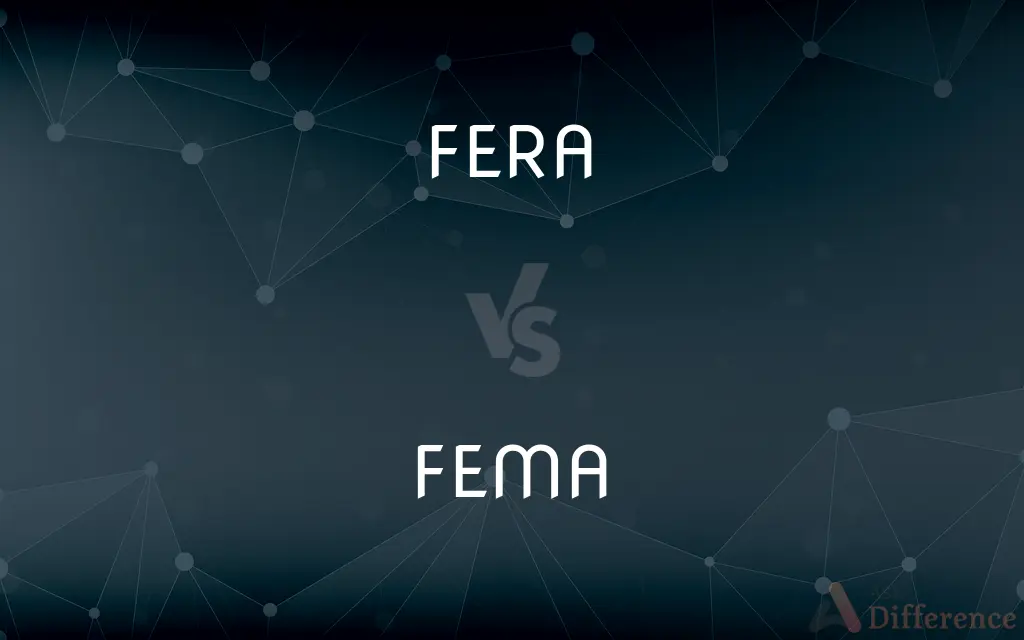FERA vs. FEMA — What's the Difference?
By Tayyaba Rehman — Published on December 11, 2023
FERA (Foreign Exchange Regulation Act) was India's legislation to regulate foreign exchange, while FEMA (Foreign Exchange Management Act) replaced FERA to facilitate external trade and payments.

Difference Between FERA and FEMA
Table of Contents
ADVERTISEMENT
Key Differences
FERA and FEMA, both originating in India, deal with the nation's foreign exchange. However, the nature and approach of these acts are where their differences lie.
FERA, or the Foreign Exchange Regulation Act, was primarily restrictive in nature, aiming to conserve India's foreign exchange reserves. FEMA, the Foreign Exchange Management Act, was introduced later to replace FERA and adopted a more liberal approach, focusing on managing and facilitating external trade and payments.
While FERA was based on the presumption that all foreign exchange transactions were suspicious and required stringent controls, FEMA moved towards a system that didn't treat these transactions as offenses but as civil irregularities. This was a significant shift in perspective.
Penalties under FERA were often severe, encompassing imprisonment for offenses. FEMA, however, is less stringent, with violations mainly resulting in monetary penalties.
Summarizing, while both FERA and FEMA are cornerstones in the management of India's foreign exchange, their core philosophies and methods of operation have distinct differences, with FEMA being the more modern and liberal of the two.
ADVERTISEMENT
Comparison Chart
Nature
Restrictive
Liberal
Main Objective
Conservation of foreign exchange
Managing and facilitating external trade and payments
Treatment of Offenses
Treats as criminal offenses
Treats as civil irregularities
Penalties
Severe, including imprisonment
Primarily monetary
Operational Years
1973-1999
1999-present
Compare with Definitions
FERA
Focused on conserving forex reserves.
Under FERA, businesses had to navigate strict forex controls.
FEMA
Adopts a civil perspective on forex irregularities.
Instead of criminal charges, FEMA violations usually led to fines.
FERA
Legislation in India to regulate foreign exchange.
The company was investigated under FERA for foreign exchange violations.
FEMA
Facilitates external trade and payments.
With FEMA in place, foreign investments in India saw an uptick.
FERA
Treated foreign exchange offenses as criminal.
Violators under FERA often faced severe legal consequences.
FEMA
Indian act that manages foreign exchange.
FEMA regulations enabled smoother foreign trade operations for businesses.
FERA
Enacted in 1973 with a restrictive approach.
During its tenure, FERA emphasized conserving India's forex reserves.
FEMA
Introduced in 1999 to replace FERA.
The government introduced FEMA for a more liberal approach to forex.
FERA
Replaced by FEMA in 1999.
With the economic liberalization, FERA was deemed too restrictive and was superseded.
FEMA
Represents a modern and liberal forex management system.
The shift from FERA to FEMA marked India's commitment to globalized trade.
FEMA
An independent agency of the United States government that provides a single point of accountability for all federal emergency preparedness and mitigation and response activities
Common Curiosities
Why was FEMA introduced?
FEMA was introduced to facilitate external trade and payments with a more liberal approach compared to FERA.
How does FEMA treat forex violations?
FEMA treats them as civil irregularities, resulting mainly in monetary penalties.
Were offenses under FERA treated severely?
Yes, FERA treated forex offenses as criminal, leading to stringent penalties, including imprisonment.
What do FERA and FEMA stand for?
FERA stands for Foreign Exchange Regulation Act, and FEMA stands for Foreign Exchange Management Act.
Which act is currently in operation in India?
FEMA is the currently operational act, having replaced FERA in 1999.
Are there any imprisonment penalties under FEMA?
Unlike FERA, FEMA doesn't typically have imprisonment penalties, focusing instead on monetary fines.
Is FEMA friendlier to foreign investments?
Yes, FEMA's liberal approach has been conducive to foreign investments in India.
Do both acts have their own guidelines and regulations?
Yes, both FERA and FEMA had/have detailed guidelines and regulations governing foreign exchange.
Did FERA and FEMA coexist?
No, FEMA replaced FERA in 1999.
Why was there a need to replace FERA?
Economic liberalization and the need for a more modern and liberal approach to forex management led to FERA's replacement.
Can businesses operate more freely under FEMA?
Yes, FEMA offers a more liberalized approach, allowing businesses to operate with greater freedom in foreign trade.
Were FERA's rules considered restrictive?
Yes, FERA was known for its restrictive nature towards forex.
What's the primary focus of FEMA?
FEMA focuses on managing and facilitating external trade and payments.
In what year was FERA introduced?
FERA was introduced in 1973.
Which act marked India's commitment to globalized trade?
The introduction of FEMA marked India's commitment to more globalized and liberalized trade.
Share Your Discovery

Previous Comparison
GMP vs. cGMP
Next Comparison
Offer Letter vs. Confirmation LetterAuthor Spotlight
Written by
Tayyaba RehmanTayyaba Rehman is a distinguished writer, currently serving as a primary contributor to askdifference.com. As a researcher in semantics and etymology, Tayyaba's passion for the complexity of languages and their distinctions has found a perfect home on the platform. Tayyaba delves into the intricacies of language, distinguishing between commonly confused words and phrases, thereby providing clarity for readers worldwide.
















































